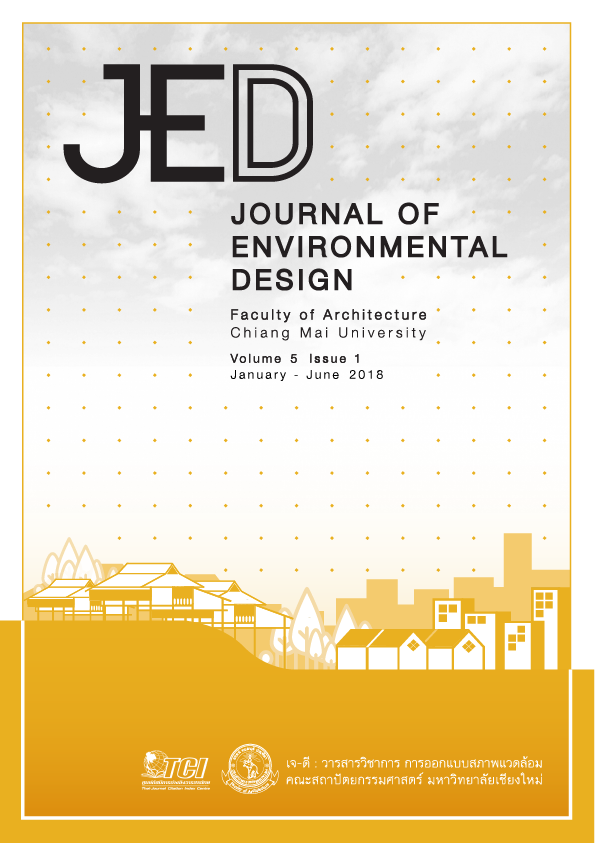การสำรวจปัจจัยทางสภาพแวดล้อมที่ส่งผลกระทบต่อคนที่มีอาการโรคไม่ติดต่อเรื้อรัง
Main Article Content
บทคัดย่อ
งานวิจัยนี้เป็นการศึกษาความเป็นไปได้ที่ลักษณะทางสภาพแวดล้อมจะส่งอิทธิพลต่อสุขภาพของผู้ที่มีอาการโรคไม่ติดต่อเรื้อรัง เนื่องจากสาเหตุสำคัญของการเกิดโรคไม่ติดต่อเรื้อรังเกิดจากพฤติกรรมการดำเนินชีวิต โครงการวิจัยนี้มุ่งเน้นการศึกษาโรคไม่ติดต่อเรื้อรังที่มีผู้ป่วยและเสียชีวิตมากที่สุดในประเทศไทยสูงสุด 4 กลุ่มโรค ได้แก่ โรคหลอดเลือดหัวใจและหัวใจขาดเลือด โรคหลอดเลือดสมอง โรคเบาหวาน และโรคความดันโลหิตสูง สำรวจกิจวัตรประจำวันที่ทำเป็นประจำของผู้ป่วยใน 1 สัปดาห์ เพื่อวิเคราะห์เปรียบเทียบกับพฤติกรรมที่แนะนำให้ทำในกลุ่มอาการทั้ง 4 กลุ่ม โดยใช้แบบสอบถามและแบบสัมภาษณ์จำนวน 135 ชุด กับผู้ป่วยในโรงพยาบาลมหาราชนครเชียงใหม่ นำกิจวัตรประจำวันของผู้ป่วยแต่ละกลุ่มโรคมาจำลองวิถีชีวิตที่เกิดขึ้นในบ้าน 2 ลักษณะ คือ บ้านพื้นถิ่นและบ้านสมัยใหม่ ผลการศึกษา พบว่า ภายใต้กิจวัตรประจำวันเดียวกันในบ้านทั้ง 2 แบบ กิจกรรมการอยู่อาศัยในบ้านพื้นถิ่นมีการใช้พลังงานจากกิจกรรมของร่างกายมากกว่าการอยู่อาศัยในบ้านสมัยใหม่ โดยการอยู่อาศัยในบ้านพื้นถิ่นสามารถเพิ่มปริมาณกิจกรรมจากกิจวัตรประจำวันปกติได้อย่างน้อย 43-205 กิโลแคลอรีต่อวัน ซึ่งเท่ากับประมาณร้อยละ 30-87 ของปริมาณพลังงานที่แนะนำให้สูญเสียต่อวัน ในขณะที่บ้านสมัยใหม่สามารถเพิ่มการใช้พลังงานได้เพียง 10-164 กิโลแคลอรีต่อวัน ซึ่งเท่ากับประมาณร้อยละ 7-64 ของปริมาณพลังงานที่แนะนำให้สูญเสียต่อวัน งานวิจัยนี้สรุปได้ว่ามีความเป็นไปได้ที่ลักษณะทางสภาพแวดล้อมจะส่งอิทธิพลต่อสุขภาพของผู้ที่มีอาการโรคไม่ติดต่อเรื้อรัง โดยมีลักษณะปัจจัยทางสภาพแวดล้อมสำคัญ 3 ประการที่มีอิทธิพล คือ การยกระดับพื้นเรือน การวางตำแหน่งห้อง และการแยกพื้นที่การใช้งาน
Article Details
เอกสารอ้างอิง
Boonyatikarn, S. (2012). Thitthang sathapattayakam Thai phuea khunnaphab chiwit khon Thai nai anakhot. (In Thai) [Direction of Thai architecture for Thais’ quality of life in the future]. Proceeding of Thai Architecture Development Direction Forum, January 27, 2012, Rajabhat Chiang Mai University, Salung-Khilek Campus, Mae Rim. Chiang Mai: Rajabhat
Chiang Mai University.
Bryant, C. W. (2008). How are sleep and heart disease related?. Retrieved May 7, 2013, from https://health.howstuffworks.com/mental-health/sleep/basics/sleep-and-heart-disease.htm.
Bureau of Non-Communicated Disease. (2016). Rai-ngan prachampi 2558. (in Thai) [Annual report 2015]. Nonthaburi: Department of Disease Control. Ministry of Public Health.
Dannenberg, A. L., Keller J. B., Wilson, P. W. & Castelli, W. P. (1989). Leisure time physical activity in the Framington Offspring Study. Description, seasonal variation, and risk factor correlates. Am J Epidemiol, 129 (1), 76-88.
Goldstein, L. B., et al. (2006). Primary prevention of ischemic stroke: a guideline from the American Heart Association/ American Stroke Association, Stroke Council. Circulation, 113 (24), 873-923. Retrieved May 7, 2013, from https://www.ncbi.nlm.nih.gov/pubmed/16785347. doi: 10.1161/01.STR.0000223048.70103.F1.
Hensgen, S. (2009). Planning for health: a study on the integration of health and planning in South Australia. Adelaide: Planning Futures Pty.
Hu, G., Jousilahti, P., Antikainen, R. & Tuomilehto, J. (2007). Occupational, commuting, and leisure-time physical activity in relation to cardiovascular mortality among Finnish subjects with hypertension. American Journal of Hypertension, 20 (12), 1242-1250. doi: 10.1016/j.amjhyper.2007.07.015.
Huerta, J.M., et al. (2013). Physical activity and risk of cerebrovascular disease in the European prospective investigation into cancer and nutrition, Spain. Stroke, 44 (1), 111-118.
Hufford, D. J. (2007). Home remedies for high blood pressure. Retrieved May 7, 2013, from https://health.howstuffworks.com/wellness/natural-medicine/home-remedies/home-remedies-for-high-blood-pressure.htm.
Kantharatanakul, W. (2000). Botbat khong kitchakam tang Kai tor kan mee ayuwatthana. (In Thai) [Role of physical activities on longevity]. Bangkok: Department of Rehabilitation Medicine, Faculty of Medicine, Mahidol University.
King, B. A. & Armstrong, D. (2006). How to control diabetes with exercise. Retrieved May 7, 2013, from https://health.howstuffworks.com/diseases-conditions/diabetes/exercise-for-diabetes-control-ga.htm.
Leon, S. A., et al. (1987). Leisure-time physical activity levels and risk of coronary heart disease and death, the multiple risk factor Intervention trial. JAMA, 258 (17), 2388-2395. doi: 10.1001/jama.1987.03400170074026.
Lind, M. (2011). Environmental health perspectives. Retrieved May 7, 2013, from https://www.sciencedaily.com/releases/2011/10/111011132048.htm
Lissner, L., Bengtsson, C., Bjorkelund, C. & Wedel, H. (1996). Physical activity levels and changes in relation to longevity, a prospective study of Swedish women. American Journal of Epidemiology, 143 (1), 54-62.
Madsakunpan, P., Salingkarinkul, T., Rewtong, K., Thimayom, P. & Wishienpaisan, P. (Eds.). (2016). Naewtang karn fuenfoo samatthaphap phupuai rok lotlueat saamhong. (in Thai) [Clinical practice guidelines for stroke rehabilitation]. Bangkok: Tanapress.
Mentzer, G. G. & Auseon, A. J. (2012). Exercise capacity in chronic heart failure. US Cardiology, 9 (1), 57–60.
Mercedes, R. C., et al. (2010). Coronary artery risk development in young adults. Hypertension, 56 (1), 49-55. doi: 10.1161/HYPERTENSIONAHA.109.147603.
Noda, H., et al. (2005). Walking and sports participation and mortality from coronary heart disease and stroke. Journal of the American College of Cardiology, 46 (9), 1761-1767.
Numpoon, J. (2014). Karn sermsang sukkhaphap darn karn okkamlangkai nai phupuai kwamdanlohitsung. (in Thai) [Exercise health promotion in hypertensive patients]. Journal of Public Health Nursing, 28 (1), 1-11.
Office of the Permanent Secretary for Public Health. (2013). Chamnuan phupuai-nai chamnaek tam klum sahed puai 75 rok jak sathanborikan sataranasuk khong Krasuang Sataranasuk Changwat Chiangmai pee 2546-2555. (in Thai) [Number of in-patients by 75 cause groups from health service units, Ministry of Public Health, Chiang Mai Province: 2003 – 2012]. Chiang Mai: Statistical Forecasting Bureau, National Statistical Office.
Ornsirin Group. (2011). Ban Ornsirin saam. (In Thai) [Ornsirin houses III]. Retrieved April 10, 2018, from www.ornsirin.co.th/home-series.
Paffenbarger R. S., Hyde, R. T., Wing, A. L., Lee, I. M., Jung, D. L. & Kampert, J. B. (1993). The association of changes in physical-activity level and other lifestyle characteristic with mortality among men. The New England Journal of Medicine, 328 (8), 538-545.
Siam Health. (2013). Karn okkamlangkai samrub phupuai rok baowhan. (in Thai) [Exercise for patients with diabetes]. Retrieved May 7, 2013, from https://www.siamhealth.net/public_html/Disease/endocrine/DM/exercise.htm.
Slattery, M. L., Jacobs, D. R. & Nichaman, M. Z. (1989). Leisure time physical activity and coronary heart disease death: the US Railroad Study. Circulation, 79 (2), 304-311.
Sutherland, E. (2004). Healthy by design: a planners’ guide to environments for active living. Canberra: National Heart Foundation of Australia (Victorian Division).
Techarungtawhin, W. (2000). Huen bha kao Lanna. (in Thai) [Northern Thai old style house]. In Faculty of Architecture, Silpakorn University Committee. (Eds.). Proceedings on the Diversity of Vernacular Thai Houses. (91-100). Bangkok: Silpakorn Publishing.
Thammarangsri, T. & Waleewong, O. (2016). NCD: sathanakan mayakhati lae kwam pen ching. (in Thai) [NCD: situation, myth and reality]. Bangkok: Thai Health Promotion Foundation.
Uthaipattanasheap, W., Khomthong, T., Ampairid, P., Khwanchun, Y., Chumpu, C. & Yodprakob, S. (2013). Ched Naewkid karn pattana muban prubprian preittikum sukkhaphap. (in Thai) [Seven concepts for village development in adaptive healthy behavior]. Bangkok: Agricultural Cooperative Federation of Thailand.
Wendel-Vos, G. C., et al. (2004). Physical activity and stroke. A meta-analysis of observational data. International Journal of Epidemiology, 33 (4), 787-798.
Willey, J. Z., Moon, Y. P., Paik, M. C., Boden-Albala, B., Sacco, R. L. & Elkind, M. S. (2009). Physical activity and risk of Ischemic stroke in the Northern Manhattan Study. Neurology, 73 (1), 1774-1779.


